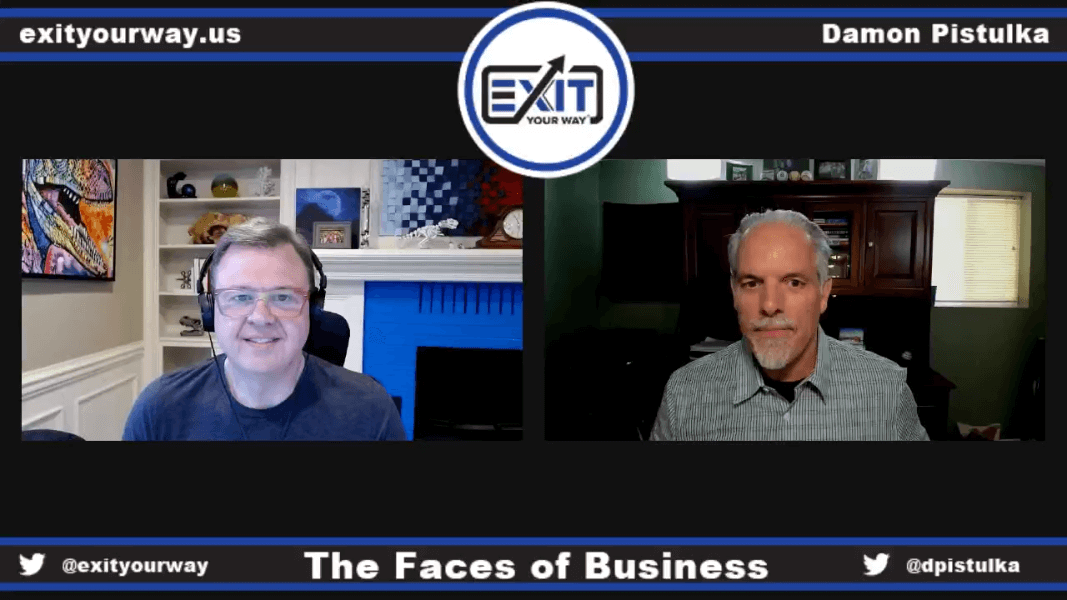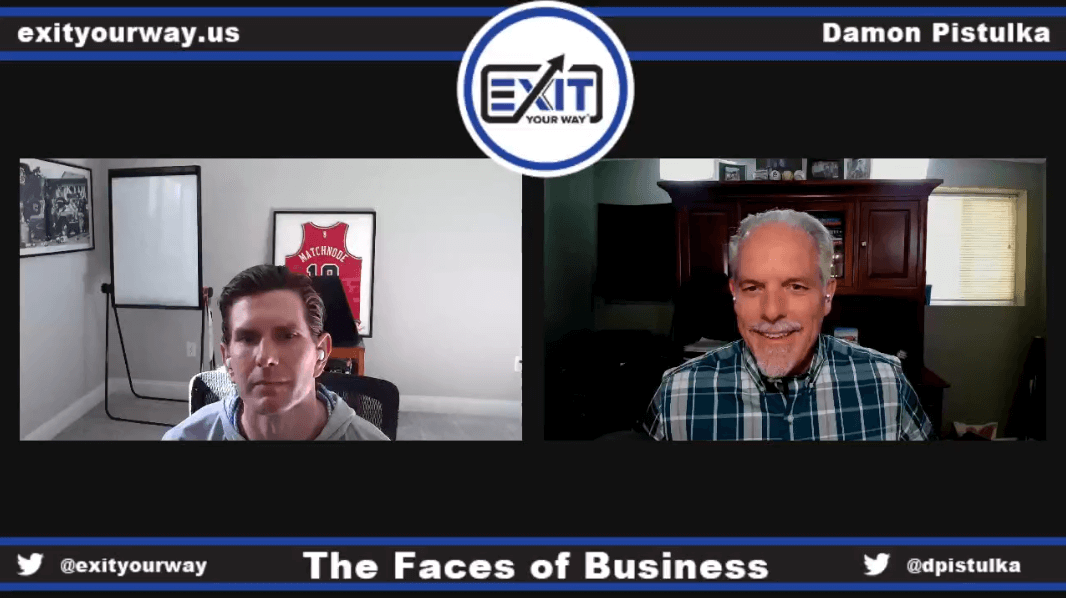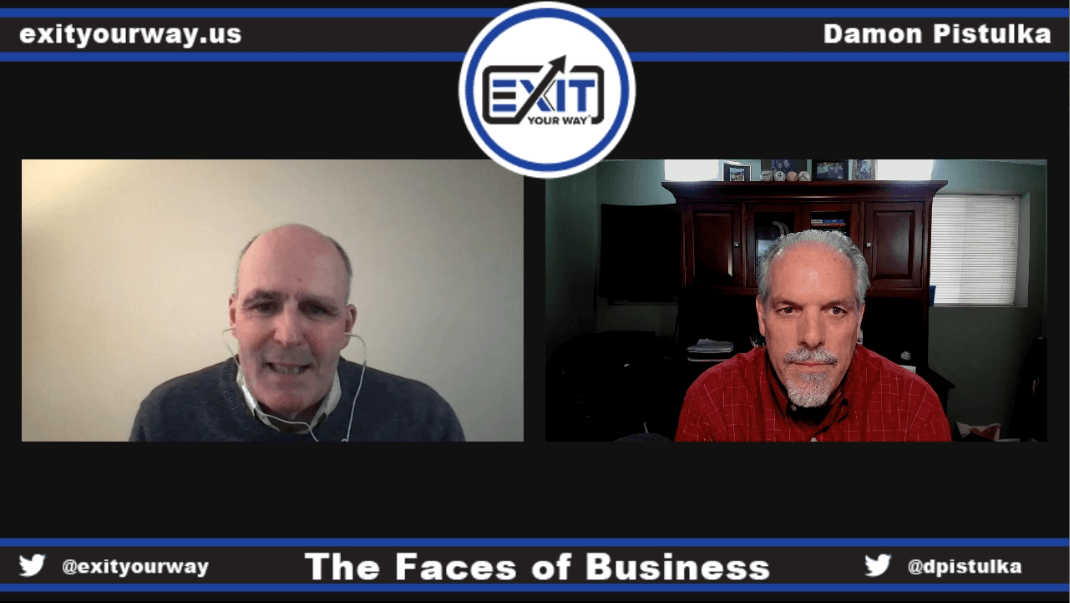36:28
SUMMARY KEYWORDS
work, people, leaders, darcy, person, problems, thinking, recognize, brain, create, solutions, feeling, leadership, team, company, business, book, retention, job, clarity
SPEAKERS
Darcy Eikenberg, Damon Pistulka
Damon Pistulka 00:01
All right, everyone, welcome once again to the faces of business. I am your host, Damon Pustaka. And with me today, I have none other than Darcy Eichenberg. And we’re gonna be talking about enhance employee retention. Darcy, thanks for being here today.
Darcy Eikenberg 00:18
Oh, hey, man, thanks so much for having me. I really appreciate it.
Damon Pistulka 00:21
Oh, man, I’m excited about this. Because, wow, the challenges that people are having, hiring, recruiting, hiring and retaining employees right now, this is a hot topic in many areas for sure.
Darcy Eikenberg 00:35
Yeah, super hot topic, even with, you know, in the news are so much around some of the big tech companies doing layoffs. And there’s all this worry and, and the economic questions, this is still happening, people are still going on, people are still leaving, and and leaders are left with holes and don’t know what to do. So it’s still a great time to really focus on engagement, retention, and you know, what you need for your business?
Damon Pistulka 01:03
Yes, it doesn’t matter what kind of business it is, you know, if you lose a key person, it’s a big deal. And that’s, that’s really what what we this addresses. So as we do, Darcy, let’s see. Tell us a little bit about your background, and how you got where you’re working on what you’re doing today.
Darcy Eikenberg 01:26
Yeah, well. So my professional background was I was in a large HR consulting firm, global firm for 15 years worked my way up from person behind the scenes to being a partner who was out in front of big deals. And I, every three years, I had the great opportunity to have a new assignment, or a new team, or I moved locations. And so I had growth without even thinking about it without even questioning it or looking for it.
And then it got to the point where the next step up, was a question mark for me was, and it all came to a head one night at a in a cold McDonald’s parking lot. I’ll never forget this. It was before we had Bluetooth, and we could do a lot of hands free call. My boss who was in the Chicago area, I was flying from Atlanta to a meeting in the Chicago area, she wanted to talk to me before this meeting.
And that was not a usual thing for her. So I got the message after I got to the O’Hare Airport. And so I got in my rental car, I pulled over into a cold McDonald’s parking lot, because I needed to, like, take the catcher on the phone. And she told me she was going to retire. And in the next breath, she told me, one of my peers, the one who was already located at headquarters was getting that job.
And then I realized what was like feeling, I was feeling relief. I was realizing that decision that was just made for me. And I realized I wasn’t striving for that job anyway. And then in the next second, I said, if I don’t want that job, what do I want to do next. And that really started my journey on just trying to figure that out. And it involved finding and hiring a professional coach. And this is 15, almost probably almost 20 years ago when not everybody was a coach, and you didn’t really know what that was.
Yeah, what I what evolved in that was recognizing where my true superpowers and strengths were. And it really was in, I could be the person in the front of the room selling the big deal, closing the business. But I was better at helping the teams and the leaders together, figure out how they can go and do it. And so that led into coaching and, and leadership development. And it’s work that has evolved to this day.
Damon Pistulka 04:03
Awesome, awesome. So what what do you think you liked most about the consulting work that you were able to do before you moved into this?
Darcy Eikenberg 04:12
Oh, there’s no question. It’s always it was always the people, right? The people that I worked with, and both my colleagues and my clients, still our makeup, some of my core network and friends today cool. It was a very collaborative company. It was a very high performing. So these were, these are smart people and I didn’t realize till I left, like how the whole world isn’t like that. It was actually it was actually surprised me and like not everybody knows that you should do this, or here’s how these things work.
So I learned so much so fast. I had so much great support from our leadership. and even when I decided that I wanted to explore the world of professional coaching, I was able to create, actually to intrapreneur, a coaching program inside my part of the business, for our team to be able to experiment with some skills and ideas that I wanted to grow and benefit the company. So I was given the space and the grace to be able to do that. And it helped me see really where I wanted to spend more time going forward.
Damon Pistulka 05:31
Wow, that was cool. So you’re able to, to kind of like, try before you buy a little bit as you’re building out something.
Darcy Eikenberg 05:39
Excellent. You know, I earned that reputation. I always say to people don’t discount. You know, when people give opportunities, you know, don’t say, Oh, well, you know, they just gave it to me. I earned it. I. I had great results. But still, it was always the people. And I think that’s still true for me today in the work I do now.
Damon Pistulka 06:00
Yeah. So as you’re, as you’re helping leaders today, figure out, you know, really the the things they need to be themselves working on to to enhance the retention. What are some of the common Danone, and I’d say challenges, but the common things that you see that people are that are happening in these these organizations? And leaders don’t even realize?
Darcy Eikenberg 06:31
Yeah, well, I think that one of the things that often gets overlooked is, are we actually clear about what people what people are feeling, what they’re saying what they’re doing, and even Am I actually clear about myself as a leader, what I’m doing, how this aligns with my values, where I’m spending time. So this is why I have a formula called the stay strategies.
And clarity is one of the first anchors in that. Because too often, I hear leaders making assumptions, you know, we go to the extreme, all people in this role do this kind of thing. And we don’t live in that world where it’s one size fits all anymore. Leadership is hand to hand combat in some ways these days.
There are lots of unique issues, there are lots of different needs, and spending the time investing the time with your people to get clear about what’s important for them. And even I’d say to start understanding what’s important for you, for the business that you want to run the way that you want to be in the business. And often just even focusing on that taking the time that you know who you are, and what you want right now can be incredibly powerful to be able to build yourself as a leader.
Damon Pistulka 08:03
Yeah, yeah. So let’s, let’s step back, I jumped ahead a little bit. But let’s step back because you you wrote the book, red cape rescue. And I think this is really relevant to because this was around individuals and smaller things to talk about that a little bit because I want to build, build upon where we’re going with developing leaders and helping them enhance retention.
Darcy Eikenberg 08:32
Yeah, so the full name of the book is red cape rescue, save your career without leaving your job. And it’s intended as a handbook for those times that we all have when you hit a speed bump at work, right when something happens. That, you know, is the catalyst moment, I think it’s the book I wish I had in that cold McDonald’s parking lot, you know, when your head is going to and all the noise outside is saying, well, if it’s not here, then I have to go somewhere else.
Like, oh, this is bad right now I have to run. And that actually, there’s brain science, why we react like that. We, you know, the brain wants to keep us safe. So either freeze or flee or we fight but most Tennessee, most of our tendency is is to freeze or flee. And I think this is what we saw during the huge disruptions during COVID of people going through mountains of change, and just something wasn’t right for them in their life at work and saying, let me go to this other option.
But I’ve had many conversations with folks who have done that and are saying, You know what, the same issues that I was struggling with that there are issues I’m having here. So the book really is intended for you to be put you back in control. And you mentioned it’s for individuals, I always remember, leaders are individuals to write leaders have issues, their careers, and business owners, entrepreneurs out.
And, you know, we all have those times where we have those hiccups. But the the book is organized by the three things that you control. You control what you think, what you say, and what you do. And that’s it. But it’s enough. And each of those three things, I give you some specific strategies, where you can, you know, look harder at what you think you can revise what you say, or you can rethink what you’re doing.
Damon Pistulka 10:50
Yeah. Yeah, that’s, that’s good, because I think, now, as you said, we were talking earlier about most of your work now is really helping leaders in these organizations work on a themselves and be the organizations to enhance retention.
So I’m thinking about the book, and I’m thinking about what you’re talking about. I have to imagine that the leaders almost if they’re if they should be reading, the read cave rescue, because a lot of the things that they’re thinking about, they might be seeing people that are not, that are maybe not perfectly, you know, they’re not happy at work, whatever, they’re just not clicking for him, that they might be able to help facilitate things for their people as well.
Darcy Eikenberg 11:42
We are never taught what we control what we don’t, you know, we’re taught and we’re fed, immediate diet, if you will, that is like, work is hard. You know, times are tough. We were and, and there’s reasons behind that. And it also you get used to how the brain reacts, right, that, you know, the brain is receptive to those negative messages, and just wants to like shrink and hide and stay safe. But that’s not how people are built to grow.
And it’s not fulfilling and create opportunities for people to bring what they do best to any workplace. So if a leader can recognize some of these strategies that I talked about, they can turn around and teach them, they can recognize for themselves where they might be, where they might need to employ some of those strategies or thinking something. They don’t have control over something or they think they, they’re frustrated, because they don’t control so many things instead of breaking down. What’s the one thing I control in here?
Could I control, asking for what I need? You know, being more specific with the ask, could I control? Assuming positive intent is a chapter do I need to literally change my thinking about what that circumstance or situation actually means? So yes, so these are tools for leaders. And as part of when we do some leadership roundtables or cohorts, within organizations to be able to dig into that and dig into what for someone personally, they might, you know, have their own blind spot or roadblock on.
Damon Pistulka 13:29
Yeah, yeah. So what do you like most about helping people develop developing people helping them develop themselves? And
Darcy Eikenberg 13:39
I guess that’s a great question. I guess the part that is always satisfying and exciting for me, is when the spark of possibility comes out the recognition of something that is in someone’s control. And it was surprising years ago, I did a series of manager groups across a very large technology company. And these were very, they were called managers, but they were pretty high level people that maybe had teams of 50 or 60, who were reporting to them to each person or group.
And inevitably, we do some hot seat coaching in that group where one or two people would take a turn and share an issue that they were dealing with, and the group would weigh in, and I would kind of coach them through. And inevitably, as we come to action, which is the other thing about the way that I like to coach, we always come to what’s the action, right? What are we going to what are we? What choice are we making now to move us forward?
Inevitably, a lot of the conversations would end with, I need to tell my manager this, I need to I need to have a conversation with my leader. I need to have the conversation with my teammate. So those things seems so simple when you Think about it. But you think about how much we swirl. And we don’t see the possibility of oh, I can actually talk to that person about this, or I can ask for that. Or, you know, whatever. So when that spark of possibility happens that I do my little happy dance. So yeah, that always that always.
Damon Pistulka 15:25
So did you see yourself doing this 20 years ago?
Darcy Eikenberg 15:28
Oh, no, no, not at all. Not at all. I mean, I seen probably to most people like a lifer in my consulting firm. And probably, if we hadn’t been to the, you know, if there had been the next opportunity or something that just was, you know, Kana to me, like most things had been handed to me in my more junior years.
You know, that I might have, you know, I might have continued on and not, but I’m really grateful that I had that that catalyst moment at that time in the parking lot. And I think we all need, you know, a catalyst moment sometimes in part of one of the things we do in coaching and leadership development is, is to intentionally create those to just take that step back, and just say, hey, is what I’m doing still working for me? Is my work still working? If? Is it aligned with who I am?
And what I want now? And if it’s not, where do I need to recalibrate or adjust? It doesn’t have to be a wholesale, I need to self harm and move, you know, overseas, but it can just be little incremental changes that keep us from burning out. So no, 20 years ago, I was, you know, deep dive into my leadership roles and focusing on my clients and my teams, and probably not making a lot of time to think about myself and what I wanted.
Damon Pistulka 17:05
Yes, I think when I think there’s a lot of that that happens, when we’re at that point is we’re so focused in what we’re doing that we don’t think about as leaders, we don’t think enough about ourselves and what really, you get so wrapped up in the work, that you forget that that you’re part of it, that has to be just as healthy and just as whole as the work you’re doing.
Darcy Eikenberg 17:31
Yeah, it’s, you know, I think it’s more magnified now, as we’re talking about things like wellness and mental health. But the The truth is that, you know, leading doesn’t just mean leading process, I mean, it means leading people. And that means that even if you think that, well, you know, my team’s not really tracking with me, or they’re not that I inherited a team, they’re not really my team. When you’re the leader level, people do look at you differently. They expect different things from you.
I remember this example, in my own career, when I moved from being, you know, just a good senior consultant to leading the entire practice for the region. And I thought, Well, I’m just darts, right, I’m just, I’m the same person I’ve always been. But I recognize that if I would say something, it would have a different impact.
And I have, I have one story that always sticks with me. I was printing something out. And I made a comment. And it was in a public shared space, made a comment that said, I don’t understand why this printer is not two sided. This seems super wasteful. And I walked away. Never thought about it again, a week later, one of the administrative assistants who was in the pool area where I went to the printer, came back and said, here’s the here’s the proposal and the costs on the two sided printer.
And I said what is it she’s like you, you said we needed to have a two sided printer. So I’m just I’m just talking. I didn’t expect someone to go into action, and then go and talk to a vendor and and spend hours working on a proposal. So that you know was met it was a way to magnify for me that as a leader, you may not see yourself differently, but people do.
Damon Pistulka 19:17
Yes. Yes. Like you said, as you were and I know a lot of people I did as well you know move from that. More of I’m in doing the work to now I’m leading the people that I was working with before some I was working before some are new. I mean, I can remember similar situations where I was saying something just really thinking talking to myself walking in and it was heard, and it’s like, whoa, you really have to learn as a leader to to and I was reading something yesterday about this is really develop a role model.
Almost kind of mentality as you’re walking around, because it’s not an off handed curse word here or there or something that you’re saying, you know, it’s just really everything is, is under under scrutiny because of that leadership responsibility.
Darcy Eikenberg 20:16
Yeah, and the only way you can do that it is humanly impossible to self manage all the time, if we haven’t taken time, the regular period to stop and kind of back up a little bit, and be able to have some external help to see our blind spots are just even to have that self reflection time to say, here are the places where I feel like I’m just slightly out of tune, you know, that I need to like, you know, the old fashioned radio, I need to move the dial a little bit this way, a little bit that way to get sharper into tune.
And Michael Hyatt, the author tells a story about in the early days, he was in a meeting with his team and his executive coach was sitting there.
And afterwards she said, well, so how’d you think the meeting went? He’s like, is great, just terrific. And, and she’s like, well, you need to tell your face that because he was, you know, he never smiled. He was, you know, all business. And the people in the room got the vibe that they you know, they were in fear. They were feeling like, everything’s a problem. Whereas he was feeling like, I’m really proud of this team. This is terrific. So our leadership, self is just as important to manage as the people that were responsible for.
Damon Pistulka 21:35
Yes, yes. Yes, I laugh because I used to have many years ago, I had a business partner that really was a was a high level thinker and didn’t didn’t really care what he cared about the business and how it ran. But we would have fairly important internal meetings, and you he might doze off in the corner if he felt like it. And people always thought they’d say things like, Well, what? He’s like, No, it’s you, you’ve got to do it. Awesome. It’s it’s just, I feel that comfortable. It over this think of the example it says how much how much you get to deal with that. But
Darcy Eikenberg 22:13
that’s still free that people create out of that, right. This is one of the chapters in the book, it’s called rewrite your story. Because often, you know, we, there’s, we all are experiencing circumstances, that circumstance, we have choices about how we interpret it. So interpreting, my boss is falling asleep in the corner could be, you know, he’s checked out, he’s a jerk, he’s rude.
It could be he doesn’t care could be I’m boring. I mean, there’s a million stories, were creating more connection, more dialogue, to be able to kind of unpack and rewrite, or maybe you’ll never know what the other person is thinking or assuming, but can you make a different choice for yourself? So that doesn’t mean I’m boring. That’s just that’s his, that’s his challenge is, you know, so yeah.
Damon Pistulka 23:03
Good stuff. Good stuff. So as you’re doing this, what? What are some of the common things that that you see across the board that, that really, leaders have not been taught? Or just don’t understand? He talked about clarity already. But
Darcy Eikenberg 23:25
like, right, one big thing that none of us have been taught is understanding how the brain works naturally. And the neuroscience on this is just fascinating. But just to keep it simple. And I refer to this before, it’s recognizing, we only control three things, what we think what we say and what we do. But the fact is, we can have some control over our thoughts. And we can be intentional about what we say, we can make active choices about what we do. I’ll often say that work is all made up.
And because the truth is that the same job in a company can look very different from person to person. And that’s often because of how it’s made up. And how the person is making it up based on what they’re good at what they’re interested in, who has taught them who what the surroundings are. And so I think for leaders recognizing that, you know, first of all, you know, everybody doesn’t recognize that there are only a lane of things they control, but they do control more than they give themselves credit for in the workplace.
We think well, that’s just how it is. But if everything’s made up, and somebody had to make up that project you’re doing, why would you continue? You know, why would you assume that It has to be done that way. I think the other piece with the brain that I wish we were teaching in school is that we’re brain is not naturally designed to be happy all the time, it is natural to have downtimes and concerns. Ideally, we want this balance by times when we’re feeling fulfilled, and, you know, happy and doing well.
But I think what happens a lot of times is when problems hit, let’s face it, problems are the language of jobs, right? You don’t have there’s not a job if there’s not a problem to be solved, yes. But when problems hit, there, things get difficult. If we don’t have the right culture, or we don’t have the right, surround, then, you know, we, we, we freeze, we think something’s wrong, we it triggers our brains that we want to go hide.
And that’s the last thing that we need for people. And so again, there are some cultures or some leaders that are great at helping people recognize that problems, road bumps, things not going according to plan is. That’s that’s our world. That’s why we have jobs, you know, we create solutions to problems. And, and but I don’t think we we often think about it that way. We think oh, just one more problem. One more problem instead of great job security, more problems to solve.
Damon Pistulka 26:38
I really liked that, because you said it was either work hard work is problems are there. That’s why we work is to solve problems. And, and yeah, people, people, it’s you can come apart pretty easy when there are extraordinary problems. And you can embrace them as well.
Darcy Eikenberg 27:00
It will. And for anybody who has been affected by downsizing or layoffs, you know, one of the things I’ll often say to folks who are looking for that next opportunity is every, every open job is a problem to be solved. And there are problems and pain out there that no one’s created a job around yet. And so when you go instead of looking for a job, and go hunting for the problems, go hunting for the pain, this even as you’re selling if you’re a company, and you’re trying to find new customers, who whose pain do you solve? If you can’t tell that story? Or you’re not clear on that, then that’s a clarity issue, right?
That’s going back to the to the groundwork. But people when you know, people want solutions to pay people, what’s the old marketing phrase, they want to aspirin, not vitamins. But, you know, this is also again, responding to how the brain works the brain, the brain response, trying to stay away out of pain out of discomfort. Those of us who know that discomfort is the only path to growth are the ones who can succeed. And so that’s another learning point for folks that it’s okay to be uncomfortable. That’s the only way you get from here to there.
Damon Pistulka 28:20
Discomfort is the path for growth. That’s good. Well, yeah, you think about it, as a leader, some of the most challenging situations that you’re put in, if you take them, reflect on them learn from him. It can be so helpful for you because and I’ll paraphrase is to are like example, because you see some people that have been through it, right? They’ve been through it, the firefighter that’s been on the job for 10 years. He goes to the house fire, and it’s like, oh, yeah, it’s burned down.
We’re gonna do this and this and the person that just started, oh, my goodness, there’s a house fire, what are we going to do? And that, in a leaders capacity can mean huge things for their team, because that leader can take that calm that that thought, yes, they might have had a really tough time and the first time this happened, but when something like that happens again, they can utilize that to be much more productive with themselves in their teams.
Darcy Eikenberg 29:26
And this also goes to knowing who you are as a leader, because I think that when we have the anchor of the clarity and when I work on this with with my coaching clients or have an online class called Get career clear that takes you through this process, the things that you discover you that you anchor into your values and your long term vision.
And those things allow you to have a framework to make choices from right because the person who values collaboration, no matter how what kind of problem comes up, they’re not going to do it alone, they’re going to lean into their values and say, Who else do we need to get involved to solve this? And so, you know, there are lots of routes to solution and no one perfect route. And I think, in a Google world or maybe chat, GBT world, we kind of assume there’s a solution. You know, there’s an answer on the other end. But that’s not what work is like, right? Yeah.
Damon Pistulka 30:31
Yes, yes. To get a little feedback here, but a way to second easily clears up. I was just reading something about that the other day, it says one of the best ways to solve a problem is to realize that the solution is not there. When the problem happens, and you need to reflect, wait, you know, you know, you know, do what you need to do to make sure the problem isn’t making a cause any more damage. But wait, because that solutions, not there. It takes that reflection and a different perspective to actually come up with the solutions. It’s so cool that you said that, yeah, no,
Darcy Eikenberg 31:13
that’s a great point. And often, we, we resist putting our foot on the next rock toward a, you know, away from what’s happening and towards something because we don’t know what that something is. We don’t know what that future is. It’s like, you know, for folks who may be, maybe they’re ready to exit their business, but they don’t know what they’re going to do next.
So they just stay on and they stay on, if they’re ready to hand over the reins to somebody else, or they’re step out of a owner role or a leadership role. And so, you know, these things, getting the clarity is such an anchor, to help you make a better decision you made the other side of the creek may not be totally clear.
But starting to put your foot on the one rock that’s in front of you, then allows you to make the choice as to what the neck rock, next rock is, and the next rock and it’s not gonna be a straight line. It’s all a zigzag. But there’s, you know, only only, you know, a million solutions to every problem. It’s just, what’s the path you’re going to take?
Damon Pistulka 32:16
Yes, yes. And that is so difficult for for business leaders and business owners in that in the exit. It’s a huge, huge decision, because often very, very life changing decision. But when you can take the time and you see people take the time, put the work in it takes work, to really think about what it’s going to be like and what they really want to be doing. Because there are different, productive say, you know, what, whatever really exciting things that they can be doing. Beyond what they’re doing now. It’s fun watching people’s mind expand as they really contemplate what they’re going to be doing. Yeah. And
Darcy Eikenberg 32:57
I think another part of that and and back to what I would like more leaders to recognize and know is there’s a part as to where I have to just trust that there, everything isn’t going to be perfect. And that’s okay. Right. I you know, I have talked to founders before, who really want to move on, there’s something else they could move on to, but the risk feels too big to leave. Because the trust isn’t fully there.
Even if they even when you dig into it. They’re like, No, this person is totally ready. And this process is super clean, and the customer base is there. But you know, there is, you know, this, how do we trust things to let it go? It’s the analogy of the trapeze. Right? You can’t grab onto that next trapeze until you let go of the one behind it.
Damon Pistulka 33:52
Yeah. Oh, that’s a great one. That’s a great one. So as you’re as you’re moving forward, now, Darcy, what are you most excited about in 2023?
Darcy Eikenberg 34:02
Oh, let’s see. I have some amazing companies that we are doing ongoing leadership roundtables with, you know, I think a lot of people in the last several years have, obviously, some, some companies have been forced to not be able to have more connection. But that’s such an important part of what people want in their life at work. They want to feel belonging, they want to feel connection.
And so creating more opportunities for people to I call creating collisions, you know, where across functions in a company that leaders are able to get together and it has structure and it’s, you know, efficient use of time, but it’s also as much for them as it’s for the growth of the company. So I’m excited about some of those projects that come my way. And I am working on a an article for Harvard Business Review and I’m working on a possible TEDx talk. And so you know, those are those things that are aspirate aspirational for me, and just, you know, kept the keep at it and and they’re always fun and, and so
Damon Pistulka 35:15
Oh, that’s awesome Darcy and it’s, it’s it’s incredible being able to talk to you and learn more about how you’re helping leaders, you know, in their development and how they can create environments that that really enhance employee retention. And just thankful that we could talk with you today.
Darcy Eikenberg 35:34
Oh, I’m so grateful for the invitation. Thank you for all you do for your clients, your people, and you know, the businesses that you’re working with every day. Yeah.
Damon Pistulka 35:43
Awesome. Awesome. Well, Darcy, thanks for being here. And everyone else that’s been here listening. Just let us know if you got any questions, go back to the beginning of this and listen to Darcy. I mean, there was a lot of golden nuggets that she dropped there and all throughout. And if you need to reach out to Darcy, what’s the best place to get a hold of you?
Darcy Eikenberg 36:05
There are lots of resources at red cape revolution.com. And I have a weekly newsletter that you can sign up for at red cape insider.com or go on my website. It’s join my insider community. That’s a great way to keep in touch. Very good.
Damon Pistulka 36:19
Very good. Well, Darcy, thanks again for being here. And we’ll be back again next week. Hang out just a moment.













